Tuesday September 16, 2014
Tallgrass Prairie National Preserve
Strong City, Kansas
Today is one of my kind of drives, only 126 miles to The Tall Grass Prairie National Preserve and then another 14 miles to Emporia RV Park in Emporia, Kansas. I guess it was an SDD (Sherry driving day). HA!
We had intended to go straight to the park, unhitch and come back to the preserve but in driving right by it seemed pretty clear there was room in the parking lot for Winnona.
From the parking lot the VC looks like a bunker built into the side of the hill. But when we get there the patio is really attractive and there is a lovely mural on the wall. I wish I’d asked if the building design idea was to be tornado proof. This IS Kansas Dorothy.
The inside of the Visitor Center is not large but it is absolutely packed with information on the Tall Grass Prairie and lucky for me an exhibit of original paintings of Smokey the Bear posters to celebrate his 70th birthday on August 9th. I love both Smokey and his elder relative Pooh.
These posters were drawn by Rudy Wendelin who was born in Kansas and began his Forest Service career in 1933 as a draftsman and illustrator. After serving as a Navy artist in WW II, he was given responsibility for the “Smokey Bear project” and proceeded to created hundreds of Smokey representations that highlighted natural resources conservation and fire prevention.
He also designed or co-designed six commemorative postage stamps including the Forest Conservation stamp in 1958, the 1964 John Muir stamp, the 1969 John Wesley Powell Stamp and the 1984 stamp of Smokey the Bear.
The original paintings for the posters are just wonderful. What a happy surprise to find them here. The details are just wonderful. Sorry for the glare in some cases. These actually aren’t all of the ones on display.
Protect Nature’s Beauty for Future Generations
Only You……Can Help Keep the Dream Alive
Careless People are the Problem
Dream of a Well-Remembered Forest Fire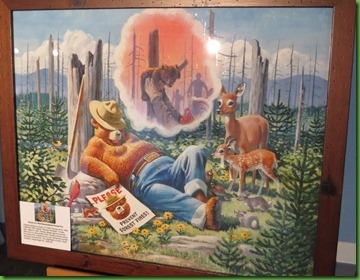
The paintings are just inside the door to the right across from the information desk. Further on into the Visitor Center is a short film and an amazingly well put together room of information, where we learn that the prairie, a place dominated by grasses and wildflowers, once ranged all the way from Canada to Mexico. Centrally located along the eastern side of the Rocky Mountains, all prairies require the same essential elements: climate, fire and grazing.
Once covering 170 MILLION ACRES, the tallgrass prairie has been reduced to less than 4% making it the most altered ecosystem in North America in terms of acres lost. Due to the impenetrable prairie upland soils, the largest tract of remaining tallgrass prairie is in the Kansas Flint Hills.
They say the “old timers” reminisced about the tall grass saying “it grew as high as a man’s head,” “we could only see the tops of the covered wagons” and “it was as tall as a man’s head on horseback”. Really? Now that is pretty darn tall if you are on a horse 15 or 17 hands high.
I knew absolutely nothing about the Flint Hills before coming here and it is clear this is an area that deserves more than the one day we have to give it. DARN!
The Flint Hills cross east central Kansas from the north near the Nebraska border and extend south into Oklahoma, where they are called the Osage Hills. The region consists mainly of alternating layers of limestone and shale. Many of the limestones, and there are different types we learn, contain concentrations of chert (also called flint)-a hard dense microcrystalline quartz. As the limestone erodes, angular fragments of flint accumulate at the surface giving the Flint Hills their name. The Native Peoples of the region, the Pawnee, Osage, Wichita, and Kansa, collected the exposed flint to make a wide variety of tools and weapons.
With soil like this you can imagine that the homesteaders skipped this area. They wanted good farmland and the rocky soil was too hard to plow. However the same rocks which made crop cultivation nearly impossible helped to preserve the native characteristics of the Flint Hills and made the area ideal for grazing. The calcium in the limestone erodes into the soil making the native prairie plants extra nutritious for grazers.
In the picture below, the extent of the limestone layers are easier to see after a prescribed burn.
There are 6 different kinds of limestone in the park. I guess I knew there were different kinds of limestone but the VC really explained these different types and where in the park you would find them. If you aren't’ interested in that just skip this next information, it’s just for me and other stoneies.
There are 4 dominant grasses of the tall grass prairie and the bloom times are nearly identical for all 4.
On the left, Little blue stem is the smallest grass here, grows in clumps and is known as beard grass for its fluffy seed tufts in the fall. It may reach heights of 2 to 4 feet tall. Its seed is eaten by songbirds and upland game birds.

Indian grass, on the left, has distinctive gold seed heads in the fall. It grows 3 to 7 feet tall. The seed head is a single, narrow, bronze-yellow panicle that matures to brown. The seed is light and fluffy looking.
Switch grass is tolerant of drought and high temperatures. It bears a good crop of seeds sought out by ground feeding songbirds and game birds. In the summer panicles of flowers are on the ends of long stems which can be up to 7 feet tall. The reddish flowers bloom from June to August before they are replaced with many seeds. In the Fall, switchgrass blades turn pale yellow and the seeds on the panicles turn beige.
Prairie plants are tall on top of the ground and have LONG root systems. All the better to tolerate drought my dear.
This little visitor center is just so amazingly well done. So much information so well displayed in such a compact space. Who are the clever people who design and set up these for the National Parks? Hats off to them!
What fun this is going to be. Just look how tall these grasses are. There are also displays on the butterflies, flowers and birds, falcons, buteos, accipters . But we are running out of time. I flip through the species guide. I’ve never seen a prairie chicken, boy would I love to but I’m not very hopeful.
This is just a great visitor center but we’ve only got one day here and we have to get outside and see this prairie.
So out we go.
The preserve has over 40 miles of hiking and nature trails. The information provided says “ All backcountry hiking trails are moderately difficult and range from 3.8 to 13 miles. Each trail offers a different and unique perspective of the tallgrass prairie ecosystem. Scenic vistas, prairie grasses, wildflowers, wildlife, and rugged terrain may be experienced along the backcountry hiking trails.”
Unfortunately for us, we have only one day to spend here and not even a full day left so we will have to skip the backcountry and seeing the small bison herd in Windmill pasture. Bison were traditionally a critical part of the tallgrass prairie ecosystem. They were reintroduced to the Tallgrass Prairie National Preserve in October 2009 when seven male and six female bison from Wind Cave National Park in South Dakota were transported to the Tallgrass Prairie's 1,100-acre Windmill Pasture. These bison are first to roam these lands in over a hundred years. The population's first calf was born on May 9, 2010. The herd numbered twenty-three animals in December 2013. Plans are to transplant an additional twelve bison from the Wind Cave Bison herd bringing the herd here closer to its planned size of 75 to 100 animals.
The trail we’ve chosen goes off behind the barn so we decide to take a look at the buildings as we go by. Unfortunately we’ve missed the only tour of the outbuildings today. The house is closed and has been for some time. No one seems to know why or when it will reopen for tours. My guess is money for renovations of some sort is not available.
This property was developed by Stephen F. and Louisa Jones when they moved to Strong City, Kansas in August of 1878 from southeast Colorado where he was engaged in a successful cattle operation. They bought 160 acres along Fox Creek in 1878 and in 1880 purchased 1,409 acres of land for $4001 from the Atchison, Topeka, and Santa Fe Railroad. They purchased additional property and amassed 7,000 acres of land.
Jones had the entire ranch enclosed with 30 miles of five-foot high stone fence to accommodate his cattle operations.
On a hill with freshwater springs surfacing, he chose a site for his new home. David Rettiger was contracted to build the house from Cottonwood limestone quarried just two miles south of the building site. In 1881, the three story stone mansion was completed at a cost of $25,000. A short time later, construction of a massive three-story barn and stable was completed, measuring 110 x 60 feet and costing $15,000. He named his estate the Spring Hill Farm and Stock Ranch. In 1882, Jones donated two acres north of his estate to the school district for the construction of the Lower Fox Creek School. Nice and close for his children.
First is the really beautiful barn. Stalls are on the ground floor where we also found the resident barn cat.
We took the stairs up to the main floor which had beautiful flooring all sorts of shoots.
The third floor was not accessible but these ramps lead to the large double doors into it.
The buildings behind the barn originally included a carriage house which would have contained carriages and buggies. It now has pieces of old farm machinery in it. Part of its double door is visible in the left of the picture below. But the most interest building is the chicken house with the sod roof. Even the chickens got a limestone house. The combination of the arched sod covered roof and thick stone walls provided protection from the harsh prairie environment. They also had a covered indoor run. Pretty sweet for chickens.
The ranch house itself is just fabulous and I am very disappointed we cannot see the inside. The front door is clearly handmade. The wrought iron fencing is lovely. I keep walking further and further down the hill to get the view that people arriving via carriage would have had.
According to local legend it took "20 men working night and day” to complete the home. There was so much activity during the construction that travelers often thought they had reached Strong City and "tried to put up for the night." And yet after only nine and a half years, Jones sold his grand estate and property on February 13, 1888, to his neighbor and banking partner Barney Lantry for $95,000. There must be a story there but I don’t know what it is.
Yes, that’s David trying to peek in the windows.
The property changed hands many many many times from that point until the last owner, Z Bar Cattle company disbanded and the 10,894 acre ranch was placed into a trust managed by Boatman’s National Bank of Kansas city. In 1996, Congress authorized a new public/private national park unit in the Flint Hills of Kansas, in order to provide a major missing element of the National Park System, the Tallgrass Prairie. The NPS will never acquire more than 180 acres by donation from the private land owner. In September 2002, thirty-two acres were donated to the NPS by the National Park Trust.
By 2004, however, the preserve’s private partner had run into financial difficulty, to the extent that it appeared portions of the land would be sold to satisfy debt and other liabilities. The Nature Conservancy responded to a request by Kansas Governor Kathleen Sebelius to come to the aid of the nation’s only tallgrass prairie within the National Park System. The main portion of the preserve will remain in the private ownership and management of the property will be through a partnership with the National Park Service (NPS). Together the NPS and The Nature Conservancy work toward preservation of the tallgrass prairie, while sharing in the story of ranching legacy, American Indian history, and the diverse tallgrass prairie ecosystem here in the heart of the scenic Flint Hills of Kansas.
This is one of many important natural places that has been saved/helped/acquired by The Nature Conservancy. As a former member of their speaker’s bureau, I salute the really fine work that they do.
As you can see, I was very taken with the house. Imagine yourself stepping out of your carriage onto these limestone steps, all cleaned up of course, to attend a function at the Spring Hill Mansion.
Just the upper part of the barn is visible in the far left of this photograph from the original road.
The back of the house shows a new rather tacky addition put on I assume before the house was acquired for the park in 1996. The raised concrete slab behind the house covers a combination storm and root cellar, like Auntie Em had, though this one is accessible from the lower level of the house. Original occupant Louisa Jones was known to be "deathly afraid" of storms and requested her husband provide easy access to the storm shelter. Today, the entire original kitchen area serves as a storm shelter to staff and visitors. So if you have to be in a tornado, this might be a great place to be.
There was also a door in the kitchen on the lower level of the house to a spring room used for refrigeration.
The structure nearest the house to the left is thought to be a curing house where meats were preserved or simply a summer kitchen.
Follow the path from the house past the summer kitchen and you’ll come to the Necessary House. Notice it’s a 3 holer. I don’t find well kept outhouses or composting toilets to be a problem at all. However, the idea of using the necessary house at the same time as someone else or two other people is a concept I have a hard time getting my mind around.
The house at the top of the hill where the trail goes out into the Prairie is another lavish feature of the ranch. Large blocks of ice were brought in winter from a nearby stream or pond and carefully insulated with straw or sawdust to provide the luxury of ice during the summer.
Not sure what the great ball of wire <wink> sitting on the path just before you arrive at the ice house is for unless just for fun. Sorry I forgot to stand next to it, it comes up to my waist. Rolling barbed wire into a ball is not something I think would be much fun.
That’s the trail going off to the left of the ice house. We’re finally going out into the prairie.
But not just at this minute. I really do hate to divide all this information about the prairie from our walk through it but this post is already too long. SO if you need the info when you read tomorrow, just open two browsers and flip back and forth using alt-tab. I do it all the time.
See you in the prairie.



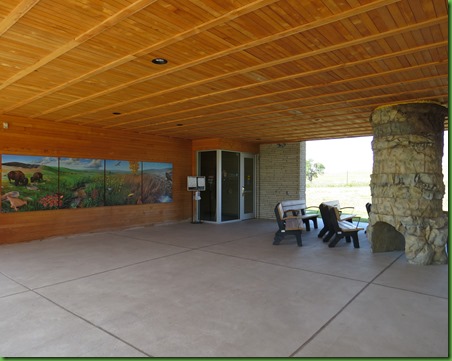





















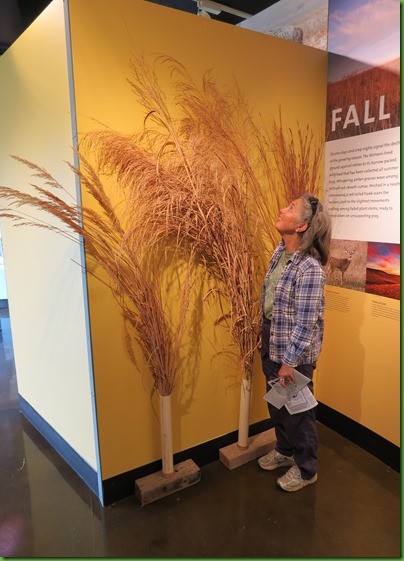





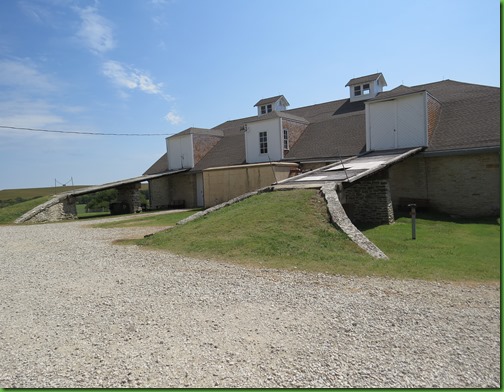
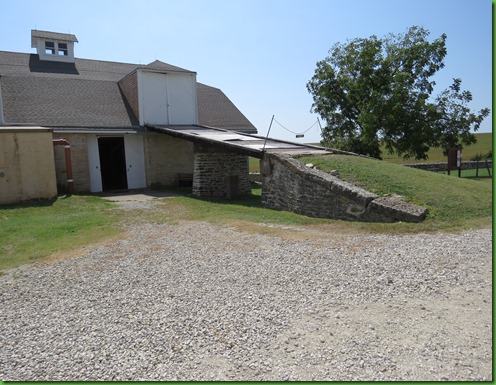











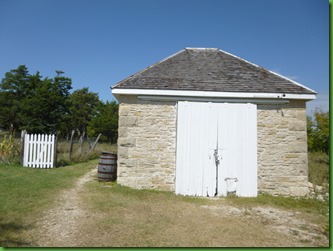

I remember there being rest areas on I-40 in northern Texas that were built into a small hill, and that they have signs indicating they are tornado shelters as well. The poster showing the above-ground vs. below-ground prairie grasses is a real eye-opener! My initial view of the Flint Hills back in the late 1970's is one I'll never forget. It's my favorite part of Kansas.
ReplyDeleteNice that you could park Winnona and save some driving time to be added to your tour time. Never heard of the tall grass prarries, but sure looks lovely.
ReplyDeleteVery informative post of many details I missed in the very fine VC. I would guess the three seater outhouse was a his, hers and the kids setup, so the women would not have to share the same seat with the men whose aim might occasionally be off target. Pure speculation, but I could see how a woman might have desired such a design, not that they would want to use all seats at the same time of course.
ReplyDeleteGreat tour! We first saw the great Prairie Grasslands when the kids were well under ten, so that was a very long time ago:(
ReplyDeleteHow informative! After reading your post we might just as well go straight to the prairie next year. Looking forward to what you think of the grasslands on your next post.
ReplyDeletewell, you know I loved ALL the posters and murals. . .really great artists!
ReplyDeleteThe house was beautiful, the barn unique, and interesting indeed. . .look forward to seeing how tall the grasses really are. . .
Hummm, a three seater. I guess a family that sits together, stays together?
ReplyDeleteWhen I was there in June 2001, I don't think that V.C. was open, maybe it was being renovated. I do remember going through the barn and the barn cat looks familiar. To see the bison at that time, you had to go on a guided tour.
ReplyDeleteInteresting area.
ReplyDeleteI don't know how you can remember all those details a month later. I sure couldn't.
ReplyDeleteIt sounds like they are doing a great job of restoring a small portion of this once vast ecosystem. The posters and stamps are wonderful. Reintroducing the bison herd must have been such a milestone for those so dedicated to this project :-) The house and barn and out buildings look very solid (and tornado proof), and beautiful. Looking forward to making the turn around the back of the ice house!
ReplyDeleteQuite interesting buildings, and to think they were built with no heavy equipment. You won't see craftsmanship like that today.
ReplyDeleteI like the program to reintroduce bison to the area. As ugly as those mighty beasts are, I just love to see them whenever and wherever I can. :c)
An absolutely amazing house. Sure wish you could have gone inside. An excuse to return. Hard to believe grasses growing so tall. I'm sure we'll see, or barely see, you amongst the grass in the next post.
ReplyDeleteThat's a beautiful visitor center... and a place I'd like to see someday. The old house is beautiful!
ReplyDeleteWhat a beautiful house!
ReplyDeleteSimply fascinating. Love those paintings of Smokey!
ReplyDeleteLooks like a wonderful Visitor's Center. We really enjoyed our time in Kansas. Our original plan was a quick two day drive across that turned into over a week. We had a great time climbing around the Kansas Badlands. Who knew there were rocks in Kansas!! Of course, there was a Presidential Library and Pioneer Museum, as well as, hiking in the Grasslands. There was another Rock Park and Salt mines which were just too far out of the way.
ReplyDeleteWell, I have to say that Kansas has not been high on our list of places to explore, but after reading this post I'm intrigued. Such an interesting visitors center and beautiful ranch! Although you may no longer be an "official" member of the speaker's bureau for the Nature Conservancy, you're doing a wonderful job through your blog of continuing to promote their work.
ReplyDeleteInteresting. I love the Smokey pictures. Smokey was from New Mexico so he has a special place in my heart.
ReplyDeleteI never knew there were so many limestones. What an interesting place, and great VC. Never heard of Tallgrass Prairie. Looking forward to the next entry :)
ReplyDelete